Punarnava Boerhavia diffusa Benefits, Dose, Side Effects
Punarnava – Boerhavia diffusa is one of the very important anti-inflammatory medicinal herbs. It is well known for its diuretic and swelling reducing activities.
Botanical Name- Boerhavia diffusa Linn. (Boerhavia repens Linn). It is also sometimes written as Berhaavia diffusa.
Family- NYCTAGINACEAE (Punarnava kula)
Table of Contents
Home remedies
By Dr MS Krishnamurthy MD (Ayu), PhD
Few simple remedies and their health benefits are mentioned here below-
Dysuria, pedal oedema
1. Punarnava root decoction in dysuria, pedal oedema and urinary obstruction:
The roots of Punarnava(15-20 gram) are taken and decoction is made. This is consumed in the dose of 30-40 ml twice or thrice a day. This is effective in conditions like dysuria and urinary obstruction.
General method of decoction preparation is –
1 tablespoon (10 grams) of coarse powder of the herb is added with 2 cups of water. Boiled in open air till the total content is reduced to 1 cup. This is filtered and used.
Abdominal distension
2. Punarnava whole plant juice with a pinch of baking soda in distention of abdomen and burping:
Fresh juice is obtained from the whole plant of Punarnava. This is taken internally in the dose of 20-30 ml by adding a pinch of Baking soda. This is effective in abdominal distention and in acid belching and burping.
Urinary calculi
3. Punarnava seeds decoction for urinary calculi:
Fine powder (1-2 gram) of Punarnava seeds or its decoction (30-40 ml) is taken regularly for a period of 10-12 days. This helps to flush out the urinary calculi of 5-8 mm size.
Recurrent UTI
4. Punarnava, Tribulus, Coriander hot infusion for recurrent UTI :
Punarnava, Tribulus and coriander are taken in equal quantities. Decoction or hot infusion is prepared. This is administered twice or thrice daily. It is very effective against burning urination, dysuria and in urinary tract infections.
Eye swelling
5. Fine paste of the leaves in swelling of eyes:
Freshly obtained leaves are made into fine paste and applied over closed eyes. This brings a cooling effect and hence relieves swelling of the eyes.
Conjunctivitis
6. Fresh leaf juice instillation to the eyes in conjunctivitis:
2-3 drops of fresh juice of the plant is instilled as eye drops. This is very effective against conjunctivitis and for purulent discharges of the eyes.
Pedal oedema
7. Poultice of whole plants in pedal edema:
Whole plant is made into a fine paste and warmed a little. This is applied to the extremities where the swelling is found. Regular application reduces the swelling of the body parts.
Urinary calculi, dysuria
8. Fine paste with tender coconut water in urinary calculi, biliary stones and dysurea:
Fresh drugs are taken and fine paste is made. 1-2 grams of this paste is taken along with a cup of tender coconut water; or else this paste is mixed with tender coconut water and kept for a while. Thereafter it is filtered and used for drinking. This has a very good effect in UTI, urinary calculi, burning during urination, biliary stones and in menopausal syndromes.
Leucorrhoea, Amenorrhoea
9. Root with rice washed water in leucorrhoea and amenorrhea:
The root or whole plant is made into fine powder. This is taken in the dose of 1-2 grams along with rice washed water or rice gruel (supernatant part of red rice/boiled rice gruel). It is a natural and safe and effective haematinic and effective in leucorrhoea and amenorrhea.
Jaundice
10. Hot infusion or decoction of Punarnava and Bhumyamalaki (Phyllanthus niruri) in jaundice:
The hot infusion or decoction is made and administered in the dose of 30-40 ml twice daily in adults. In children the dose can be restricted to 20 ml. This is effective in obstructive jaundice. It acts as cholegogue (pittasaraka) also.
In many parts of the country this is also used as a vegetable. This is very beneficial to those who are suffering from heart diseases and anemia. However there is a need to popularize this herb as a vegetable. Such a move will help the sufferers who are in search of new varieties (changes) in their diet, tailor made for their disease.
Click to consult Dr MS Krishnamurthy MD (Ayu), PhD
Vernacular Names
Telugu Name- Atikamamidi
Common name – English Name- Spreading Hogweed, Red Hogweed, horse purslane, pigweed, Red spiderling, Tarvine
Tamil Name- Mukaratte- Kirai
Punjabi Name- Itsit
Marathi Name- Ghetuli
Assamese name – pananua
Bengali name punarnova
Chinese name: huang xi xin
French name (Fr. Guiana): ipecacuanha de Cayenne
Gujarati name: satodi
Hindi name: gadha-cand, Gadahpurna, Gadah bindo
Kannada name: komme
Konkani name: punarnava
Malayalam name: talutama, tavilama, thazhuthama
Marathi name: ghetoli, ghetula, punarnava, vasu
Nepalese name: punarnava
Portuguese name (Brazil): agarra-pinto, celidônia, pega-pinto
Spanish name: hierba de cabro
Tamil name: mukkurttaikkoti, Mukaratee-Kirei
Telugu name: atakamamidi, punar-nava
Urdu name: tukhm-i-ispast, Tukhm-e-Ispat
(white variety is known as Horse Purslane in English and Gulijeru in Telugu)
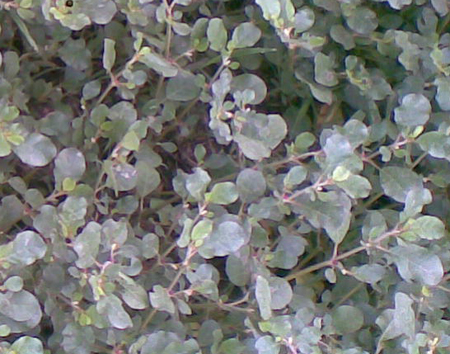
Photo courtesy: Sheji Ramkumar
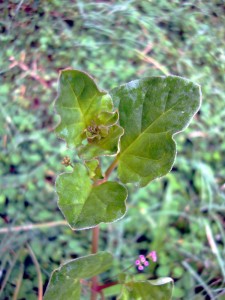
Sanskrit Synonyms
Punarnava, Punarbhu – Punar means again Nava, means new. The plant dies off in a year and with the same root, next year, it regrows. Hence the name. Also, Punarnava is an excellent anti aging herb. It makes the body new again, so the name Punarnava.
Katilla, Kathillaka, Shilatika, Varhsabhu, Jatila, Shivatika, Vruscheera,
Shophaghni, Shothaghni – Useful in relieving inflammation, swelling etc.
Classical Categorisation
Charaka –
Vayahsthapana – anti aging group of herbs
Kasahara – group of herbs useful against cough
Anuvasanopaga – Group of herbs useful in oil enema
Svedopaga – useful in sweating treatment
Sushruta-Vidarigandhadi Gana
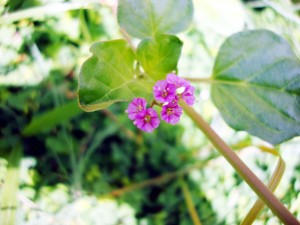
Varieties, distribution
Punarnava – Hogweed – Different varieties
Two types of Punarnava are explained.
Shweta – white variety (based on color of stem and flower) – also known as Varshabhu – Trianthema portulacastrum Linn (AIZOACEAE)
Rakta – red variety (based on color of stem and flower)- Boerhaavia diffusa.
In Raja nighantu another variety “Nila Punarnava” – Blue variety, is also described.
The plant is available in two forms white and black (red). The second one is more effective in the clinical field.
Distribution:
It is found in many places of Africa, North and South America, Myanmar, China and India.
Morphology
Annual herb
Stem- Prostrate or ascending glabrous stem with distinct swollen nodes, stem is diffusely branched.
Leaves- Opposite, unequal, exstipulate, simple, ovate with rounded or cordate base, margin is entire, apex is obtuse, dorsal surface is green and lower surface is silvery white in color.
Inflorescence- Flowers crowded in heads at the end of long slender stalks forming terminal panicles.
Flowers-Bracteate, small, minute, red in color, perianth lobes are 5, pink in color, gamophyllous, stamens are 2 to 3 in number,
Fruit- A clavate and 5-ribbed achene.
Chemical constituents
Boerhavia diffusa Chemical Constituents
Hentriacontane, B-sitosterol, Oxalicacid, D- glucose, Punarnavoside, Punarnavine-1, Punarnavine-2 Boeravinones A,B,C etc
T. Portulacastrum- Trianthemine and ecdysterone.
It also contains two rotenoids – Boeravinones G and H
b-Sitosterol, a-2-sitosterol, palmitic acid, ester of b-sitosterol, tetracosanoic, hexacosonoic, stearic, arachidic acid, urosilic acid, Hentriacontane, b-Ecdysone, triacontanol
(Reference: Illustrated Dravyaguna Vijnana, Vol. II, by Dr JLN Shastry) (1)
The herb contains beta-sitosterol, alpha-2-sitosterol, palmitic acid, arachidic acid, hentriacontane, ursolic acid, hypoxanthine-9-arabinofuranoside, two retinoids- boeravinone A, B, C, D, E & F, two new retinoids- repenone & repenol, bothavine etc. The main constituents are Punarnav Side (antifibrinolytic glycoside), boeravinone A-E, lignans, flavones, sterols, boeravinone and hypoxanthine-9-L-arabinofuranoside. They have anti inflammatory, analgesic and regenerative properties.
Medicinal properties
Punarnava medicinal Properties
Rasa (taste) – Madhura (sweet), Tikta (bitter), Kashaya (astringent)
Guna (qualities)- Laghu (lightness), Rooksha (dryness)
Vipaka- Katu – Undergoes pungent taste conversion after digestion.
Veerya- Ushna – Hot potency
Effect on Tridosha
Balances Kapha and Vata Dosha.
Bhavaprakasha – Rakta Punarnava as Sheeta Veerya -coolant
Part used, dosage
Part Used- Whole plant, root, and leaf
Dosage- fresh Juice 5-10 ml, powder 1-3 g. Decoction (Kashaya) – 50 – 100ml in divided doses per day.
Sanskrit verse
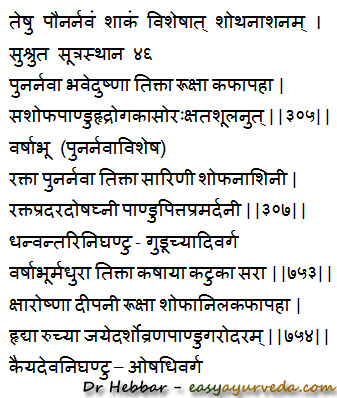
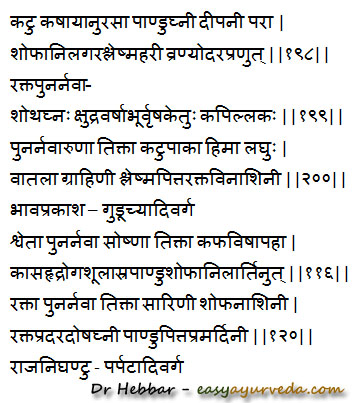
Rakta Punarnava uses
Rakta Punarnava – Boerhaavia diffusa medicinal uses:
Shotha Nashana, Shophahara – Reduces swelling, anti inflammatory
Panduhara – Useful in anemia, early stage of liver disorders
Hrudrogajit – Useful in cardiac disorders.
Punarnava is an excellent diuretic. In cases of high blood pressure requiring diuretic action, punarnava is used.
Kasanut – useful in cough and cold
Kaphapaha – relieves sputum
Urakshata – useful in chest injury
Shulanut – useful in relieving pain, abdominal colic.
Raktapradaradoshaghna – Useful in heavy periods, menorrhagia
Kshara – slightly alkaline in nature, scraping, cutting qualities
Deepani – improves digestion strength
Ruchya – improves taste, useful in anorexia
Arsha – useful in Hemorrhoids
Vranahara – speeds up wound healing
Udarahara – Useful in ascites
Gara Visha – Useful in chronic toxic conditions
Because of its diuretic action, it can be used in relieving urine retention, where structural anomaly is not the cause for the retention.
It is also quite useful in relieving water retention as in case of adverse effects of long term use of steroids.
Its seeds are used for the purpose of aphrodisiac treatment.
Its root decoction (Kashaya) is used in treating snake bites, rat bites etc.
Shweta Punarnava uses
Varshabhu – Shweta Punarnava – White variety – Trianthema portulacastrum Linn
Ushna – hot
Tikta – bitter
Kaphahara – relieves sputum
Most of the qualities are quite similar to the red variety.
Raja Nighantu has explained about Neela Punarnava (blue varient) with almost similar qualities and usage)
Boerhavia side effects
Because it acts as diuretic, it needs to be used with caution in patients with high BP and kidney disorders.
Safe to use during lactation period and in children. Medical supervision is required during pregnancy, to use it.
Interaction with medicines, supplements
Can this be used while taking Homeopathic medicine?
Yes. This product does not react with homeopathic medicine.
Can this medicine be continued while taking supplements like multivitamin tablets, Omega 3 fatty acids etc?
Yes. Generally, this product goes well with most dietary supplements. However, if you are taking more than one product per day, please consult your doctor for an opinion.
With western
medicines
Seek your
doctor’s advice if you are taking this product along with other western
(allopathic / modern) medicines. Some Ayurvedic herbs can interact with modern
medicine.
If both Ayurvedic and allopathic medicines are advised together, then it is
best to take Allopathic medicine first, wait for 30 minutes and then take the
Ayurvedic medicine.
Research
A quinolone alkaloid, lunamarine, isolated from Spreading hogweed has shown some in vitro anticancer activity.
Anti-microbial properties
Phytochemical screening
Ayurveda medicines
Ayurveda medicines with Punarnava Ingredient:
Punarnava Mandur Tablets – A very famous Iron based tablet with Punarnava as main ingredient, used in the treatment of Anaemia, splenomegaly, piles, fever etc, it is especially used in children.
Punarnavadi Guggulu – used in the treatment of gout, sciatica, low back ache etc.
Narayan Oil – used in the treatment of many neuro- muscular and skeletal-muscular conditions, such as arthritis, neuralgia.
Sukumaram kashayam – Useful in constipation, menstrual pain
Amritaprasha Ghrita – Used for the treatment of burning sensation, fever, bleeding disorders, cough, etc.
Sthanika Karma (Systemic Action)
External Application – Punarnava cures edema and has a scraping action on the body. In edematous conditions, punarnava can be used for sweating treatment, poultice, as a paste form, or even as oil prepared out of it, which is also beneficial for external application. Its juice is indicated in eye disorders.”
Internal administration-
Digestive system – Carminative, Facilitate movement of doshas in normal direction, induce purgation. overdose can cause vomiting. Indicated in Indigestion, Ascites, constipation etc.
Circulatory System – Cardiac stimulant, stimulates RBC production. Highly beneficial in edema, Anemia, Heart diseases etc.
Respiratory system – indicated in cough, breathing disorders, chest injury etc.
Reproductive system –Seed is Aphrodisiac. In menorrhagia root of the red variety of punarnava is beneficial.
Excretory system – It is indicated in Dysuria, UTI etc. Helps to increase urine output
Tapakrama – Indicated in fever (chaturthaka jvara / quaternary type of fever)
Tvak – Indicated in skin disorders
Satmikarana – Ant poisonous and Rejuvinative. indicated in Animal poisoning.



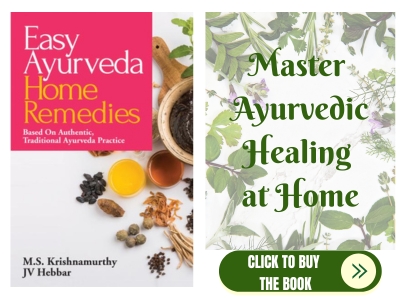







50 comments
Prahladbhai D. Patel
Thank You sir.
Prahladbhai D. Patel (Gandhinagar - Gujarat )
Sir, Your teaching of Ayurved will make us semi ayurvedik doctor and we will be able to self curing our health that will be blessing of god to you by readers.Very much thanks..
Baldev Awasthi
is punernva works on hydatid cyst in liver
UNNIKRISHNAN
Its very good to our knowledge
Dr J V Hebbar MD(Ayu)Author
You can add. No problem. Check your Blood pressure frequently.
nitin
hello sir,i want to purches this punarnava plant leaves for my project,
Plese give supplier name in maharastra,pune
Dr J V Hebbar MD(Ayu)Author
It may not cure your problem. Considering your illness, it is best for you to consult an Ayurveda doctor directly. Please do so at the earliest.
Nirmala
Hello Doctor, Regards. given very good information. You mentioned to use this punarnava for patients having kidney disorders. My niece got kidney problem due to high dose of antibiotic. Shall she use this continuously, if so for how many days?. kindly explain. Thanks.
Prabhat
Sir
Is there a treatment for polycystic kidney disease in Auyurveda? Kindly advise
Dr J V Hebbar MD(Ayu)Author
Please contact Sridhar Aggarwal –
Dialysis – Kidney care – +91 9646638515, +918699017567 Dr Aggarwal Panchakarma Center
DIPAK KAMDAR
respcted Doctor,
i am oprataed last month for my prostate problem sucessfully,till today one alfusin tablet is going onat bed time.urine flow is good but after mornning hour i faced very low come out of urine,bladder is not get empty i have to visit frequentely to bathroom for urination.oprtaed dr,said during the night if flow is good then urination passage is clear no need to fear it will be ok.but problem is persist.
then after i started help of homepathic medicine and punarnava capsule and i found ok.
today i expriment rasayan churna it also help me as a dirutic,
sir, can you help to to advise that puanava can be taken regular basis.will it harm for regular use,i also taken allopathic stemalo 5 for my bp problem.
with best regards.
DIPAK KMDAR
SUJIT KUMAR PAL
I am a CKD patient.Doing my office and other work almost normaly.Last Blood Report: creatinine 5.1 Urea 132 Himoglobin 11 sodium and Potassum normal.Water intake and urine outflow is quite normal. No swealing of body.Is Punarnava useful for me?
parul
sir , can we get punarnava in a tablet form , as i had been used punarnava in a liquid form, during jaundice…and was amazingly effective…but the only problm is that its taste is very horrible….so cnt drink properly…sometimes i vomit it….so can u tell me is it available in a tablets also…so that i could take it without any problem…..thnk u Sir.
Vijay
Sir is punarnava benifecial in treatment of hypothyroidism
Rama s murthy
Sir I have got swelling at ankles & face Dr said there is water retention in lungs & lack of oxygen I am using lasics will punarnava helps me in this case
Muniya
Is punarnava helpful for gallstones issues.
Dr J V Hebbar MD(Ayu)Author
Not to a great extent
Fola
Thanks for the load of information. Please I want to know if this herb can be extracted into a coconut oil medium as to combine the medicinal values of the two. Thanks.
Pramod
Is Punarnava Mandur Tablets useful in swelling of feet?(Instead of allopathic medicine like,Tab Lasix,Tab Novamox 250 mg and Tab Topcid40 mg) How many days to take,Please reply,
Thanks.
Dr J V Hebbar MD(Ayu)Author
Punarnava mandoora is useful in feet swelling treatment but it cannot replace lasix.
Pramod
Thanks Dr.
Shankarnarayan
Can Punarnave be used for Frozen shoulder
VIKAS MARG
How can we take Punarnava powder. Pls inform the dosage and how to take it for kidney cyst problem for 77 years age female
Muniya
Sir, how much amount of punarnava powder should we take for weight loss purpose.. Plz guide.Thankx
Umesh
In case of CKD, I found improvement by Himalya Punarnava and Baidnath gukshuradi gugulu. will this be for long time ? how long we can continue these medicines ?
thanks Umesh
Thea
Can punarvana tablets cause cramps? I have been taking the tablets to reduce my body excess water (specially in my legs). But I have been noticing that during the night when I have taken the tablet I do have cramps. (my hands are dying and time to time my legs too.) if I’m not taking the tablet in then I do not have cramps.
Noname
Hi!
I took Punarnava because I was told that it helps in iron deficiency anemia. However, I have lost almost 5 kgs because of it. I believe it is because of it is anti diuretic ( water weight- as my skin and mouth are really dry as well), and I can’t gain it back, which wasn’t the case before. I am quite under weight now. Is there any other herb that I can use to reverse the effects?
Thanks!
Noname
I actually tried Ashwagandha, but it didn[‘t help.
Anu
Hello sir
IS punarnava plant is useful of liver disorder and how to use plant to get rid of liver disorder
Anu
It’s hep b inactive
Anu
It’s hep b inactive n Am taking puranavana decotion twice a days . N beetroot juice every alternate days
Dr J V Hebbar MD(Ayu)Author
It can be useful.
Hena A K
My mother has been using it for her heel pain. She has high BP and takes medicine for the same daily. Is it okay to continue and for how long?
Muskaan
Hi.
I have been trying to search for punarnava powder, but haven’t got that. Where is that sold? If not powder what other ways of this is available and where will I get it?
Also I have PCOD problem I am 30 yrs old, my body there is lot of swelling, is it advisable to take this? Will there be any side effects as I have PCOD?
Please reply fast as I want to start with this as soon as possible..
Dr J V Hebbar MD(Ayu)Author
No need of it for you.
rose
a person on blood thiner can take it or not
M. Swamy
dear sir, i have kidney stone about 6 mm in RK and 4 mm in LK,recently kidney swelling is there(hydro nephrosis). how to cure plz suggest me. thank Q.
Hemashree
Sir. My mother have mild cystitis at bladder and right renal infection wild stasis and cystitis. For this which ayur. Product is best n how to use sugest us plz. Thank you.
Kumar
Sir my father have prostate cancer treatment (radiation therapy going on) he feel week and no appetite low oxygen . Please let us know what medicine will help him . I order punernava powder allready and it on the way if you think any other medicine good for him. Thanks
Larry
Hi Dr. Hebbar,
You say the Tridosha effect of Punarnava is that it balances Kapha and Vata. This makes me wonder if, taken by itself, will it aggravate Pitta? If so, is it better to take it in a formula? My [limited] knowledge is that Vaidyas don’t traditionally prescribe single herbs.
Dr J V Hebbar MD(Ayu)Author
It is not as Pitta aggravating as spices. It is mild on Pitta. It is true that most of Ayurveda products are polyherbal combinations.
Larry
Thanks for your response. And as always, thank you so much for all you are doing to spread the knowledge of Ayurveda.
Dr J V Hebbar MD(Ayu)Author
Welcome!:)
Dave Holmes
is it ok to take 3 – 5 gram of Punarnava powder a day , on an ongoing basis ? I find it reduces my blood sugars just enough to keep me off the metformin ? are there any side effects to long term use ? should I reduce to 2 – 3 gram a day ?
thanks
Dave from England
Dr J V Hebbar MD(Ayu)Author
3 grams per day is fine to use on long term.
Dr J V Hebbar MD(Ayu)Author
Thanks.
1 tablet at night after food can be given for 2 months time.
Since it contains Iron content, better to talk to her urologist once, to confirm she can take medicine with iron content.
David Holmes
Thankyou Dr Hebbar , apologies for my delayed appreciation . I wish I knew my actual Dosha. An Ayurvedic chap in Arumbol mixed me a powder 1/4 Varta – Kapha. that was used up after 4 months…. this is why l purchased the Purnanava
thanks again :))
David
Rohini
Sir. I rohini. Recently. I checked my TSH is 9.2 and irregular menstruals sice 4 months. Plz suggest me. Thank you
Ganesan K V
Dear Dr,
I am aged 78.My creatinine level last six months average 1.7 and urea 25. Can i take Punarnava powder twice per day before foods to reduce creatinine level?
Thanking you
yours
Ganesan KV
Dr J V Hebbar MD(Ayu)Author
Sir, it is best to consult a doctor directly.